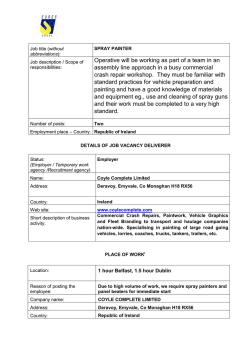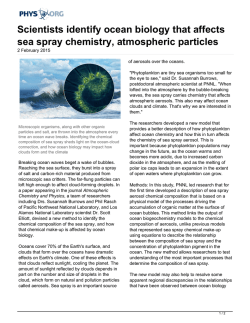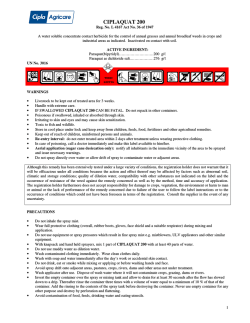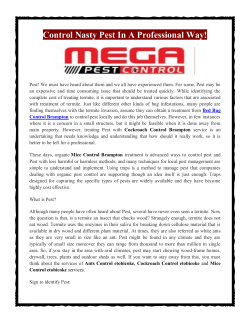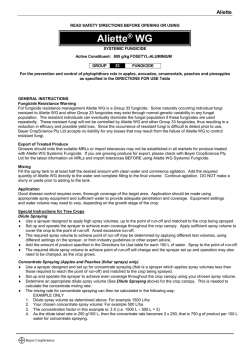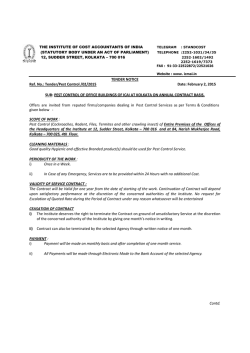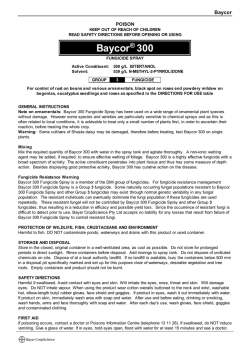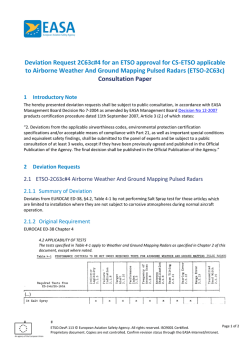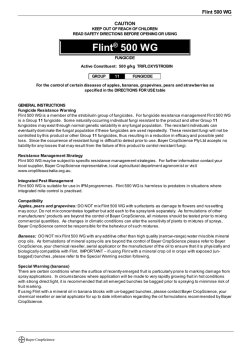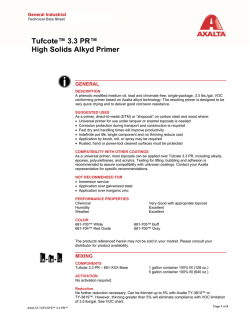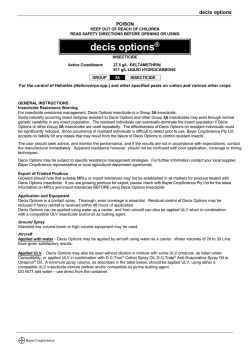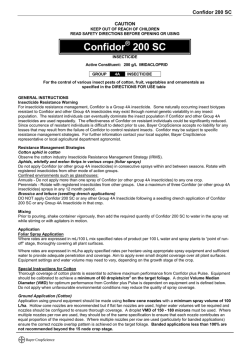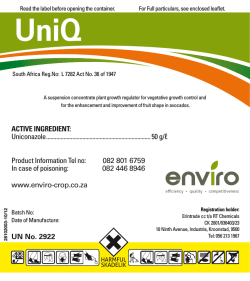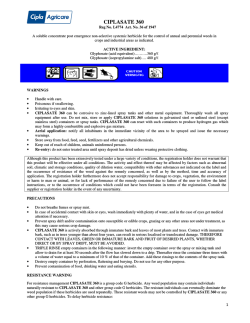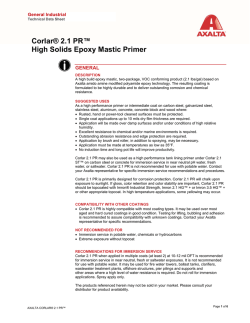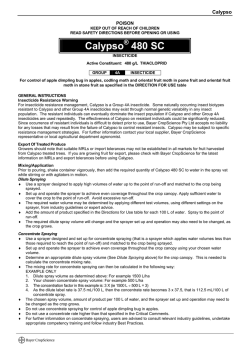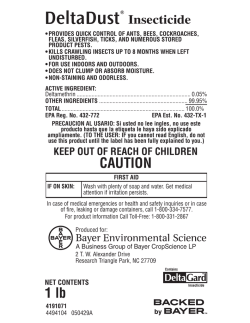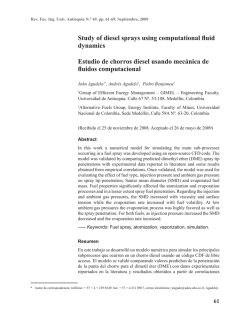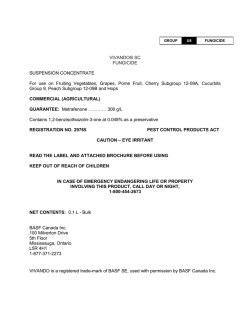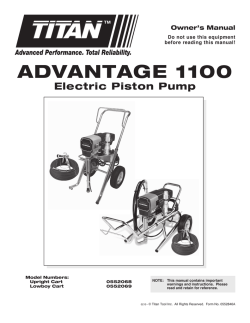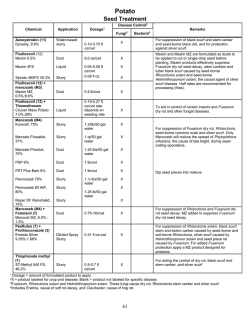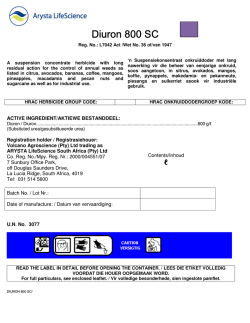
Larvin 375 - Bayer CropScience
Larvin 375 POISON KEEP OUT OF REACH OF CHILDREN READ SAFETY DIRECTIONS BEFORE OPENING OR USING Larvin® 375 INSECTICIDE Active Constituent: 375 g/L THIODICARB (an anticholinesterase compound) GROUP 1A INSECTICIDE For the control of insect pests in a range of crops as per the DIRECTIONS FOR USE table GENERAL INSTRUCTIONS Larvin 375 is a non-systemic insecticide, which means that new growth appearing after application will not be protected against insect attack. This product is an aqueous suspension concentrate formulation that readily disperses in water for spraying by ground or air equipment. It is unstable under highly acidic or highly alkaline conditions, being hydrolytically sensitive to degradation of active constituent by strong acids, strong bases and certain heavy metals and salts. DO NOT apply when weather conditions favour drift from the area to be treated. Larvin is only moderately rainfast - rain within 3 hours of application may reduce the effectiveness of this product. Insecticide Resistance Warning For insecticide resistance management, Larvin 375 Insecticide is a Group 1A insecticide. Some naturally occurring insect biotypes resistant to Larvin 375 and other Group 1A insecticides may exist through normal genetic variability in any insect population. The resistant individuals can eventually dominate the insect population if Larvin 375 or other Group 1A insecticides are used repeatedly. The effectiveness of Larvin 375 on resistant individuals could be significantly reduced. Since occurrence of resistant individuals is difficult to detect prior to use, Bayer CropScience Pty Ltd accepts no liability for any losses that may result from the failure of Larvin 375 to control resistant insects. Larvin 375 may be subject to specific resistance management strategies. For further information contact your local supplier, Bayer CropScience representative or local agricultural department agronomist. Export of Treated Produce Growers should note that suitable MRLs or import tolerances may not be established in all markets for produce treated with Larvin 375 Insecticide. If you are growing produce for export, please check with Bayer CropScience Pty Ltd for the latest information on MRLs and import tolerances BEFORE using Larvin 375 Insecticide. Mixing Agitate or shake container prior to use. Remove oil, rust, scale, pesticide residues and other foreign matter from sprayer and strainer. Flush with clean water. Use 50 mesh or slotted strainer in spray system. Fill tank approximately half full of water, add this product and mix thoroughly by mechanical or hydraulic action. Add water to desired volume and thoroughly mix again. Application This product may be applied by air or ground equipment. Use a minimum prepared spray volume of 20 L/ha by air (30 L/ha for cotton, 50 L/ha for maize or sweetcorn) and 50 L/ha by ground. A droplet density of a minimum 60 droplets per cm2 must be attained. There needs to be some air movement, which preferably should be blowing across the flight path. After use, drain and flush sprayer with water. Compatibility Larvin 375 may be mixed with DiPel ES, Delfin WG, most other foliar Bt products, Thiodan® EC, Folidol® M500, Bayer Chlorothalonil, Folimat®, Le-mat®, Marlin®, Marlin® 225 and most EC formulations of profenofos and dimethoate. Larvin 375 is physically compatible with Bulldock® Duo, Decis Options®, Gemstar®, Intrepid, Karate, Karate with Zeon, Marlin®, Regent® 200SC, Reign™ and Steward. However, before preparing tank mix combinations, it is advisable to mix a small amount of Larvin 375 with an equal volume of water in a small container and add the other pesticide. Any mixture which curdles, precipitates or greases should not be used. Larvin 375 may also be mixed with Dithane M-45, Penncozeb® 420 SC (up to 1.8 L/ha), Penncozeb® 750 DF (up to 1.0 kg/ha) and copper oxychloride, PROVIDING the mixtures are used within 6 hours. Larvin 375 is NOT compatible with other copper- and manganese-based products, zinc-based products including Dithane DF and Dithane Rainshield, with LV, ULV or other oil-based formulations, or with vegetable oil diluents. As the formulations of other manufacturers’ products are beyond the control of Bayer CropScience, all mixtures should be tested prior to mixing commercial quantities. Larvin 375 PRECAUTIONS DO NOT allow children access to treated areas. When the product is being applied, human flaggers/markers must be protected by engineering controls such as vehicles with cabs. Re-entry Period Do not allow entry into treated areas for 1 day after treatment. When prior entry is necessary, wear cotton overalls buttoned to the neck and wrist and a washable hat, chemical resistant gloves and impervious footwear. Clothing must be laundered after each day’s use. DRIFT WARNING DO NOT apply under weather conditions or from spraying equipment which could be expected to cause spray to drift onto adjacent crops, crop lands, pastures or livestock. PROTECTION OF LIVESTOCK Dangerous to bees. DO NOT spray any plants in flower while bees are foraging. PROTECTION OF WILDLIFE, FISH, CRUSTACEANS AND ENVIRONMENT Dangerous to fish and aquatic organisms. DO NOT contaminate streams, rivers or waterways with the chemical or used containers. STORAGE AND DISPOSAL Store in the closed, original container in a dry, cool, secure, well-ventilated area. Do not store for prolonged periods in direct sunlight. Triple or preferably pressure rinse containers before disposal. Add rinsings to spray tank. Do not dispose of undiluted chemicals on site. If recycling, replace cap and return clean containers to recycler or designated collection point. If not recycling, break, crush, or puncture and bury empty containers in a local authority landfill. If no landfill is available, bury the containers below 500 mm in a disposal pit specifically marked and set up for this purpose clear of waterways, desirable vegetation and tree roots. Empty containers and product should not be burnt. SAFETY DIRECTIONS Poisonous if absorbed by skin contact, inhaled or swallowed. May irritate the eyes and skin. Avoid contact with eyes and skin. Do not inhale spray mist. Obtain an emergency supply of atropine tablets 0.6 mg. When opening the container, preparing spray and using the prepared spray, wear cotton overalls buttoned to the neck and wrist, a washable hat, elbow-length PVC gloves, impervious footwear and, goggles and a half facepiece respirator or, full facepiece respirator with combined dust and gas cartridge. If product on skin, immediately wash area with soap and water. After use and before eating, drinking or smoking, wash hands, arms and face thoroughly with soap and water. After each day’s use, wash gloves, goggles, contaminated clothing and respirator. Wash rubber respirator with detergent and warm water. FIRST AID If poisoning occurs, contact a doctor or Poisons Information Centre (telephone 13 11 26). If swallowed, give one atropine tablet every 5 minutes until dryness of the mouth occurs - if poisoned by skin absorption or through lungs, remove any contaminated clothing, wash skin thoroughly and give atropine tablets as above. Get to a doctor or hospital quickly. MATERIAL SAFETY DATA SHEET Additional information is listed in the Material Safety Data Sheet, which can be obtained from www.bayercropscience.com.au. EXCLUSION OF LIABILITY This product must be used strictly as directed, and in accordance with all instructions appearing on the label and in other reference material. So far as it is lawfully able to do so, Bayer CropScience Pty Ltd accepts no liability or responsibility for loss or damage arising from failure to follow such directions and instructions. Bulldock®, Decis Options, Folidol®, Folimat®, Gemstar®, Larvin®, Le® ® mat , Marlin and Thiodan are Registered Trademarks of Bayer. Reign is a Trademark of Bayer. APVMA Approval No.: 49254/1203 CARBAMATE PESTICIDE, LIQUID, TOXIC (contains thiodicarb) UN No. 2992 PG III HAZCHEM 2X FOR 24 HOUR SPECIALIST ADVICE IN EMERGENCY ONLY PHONE 1800 033 111 Larvin 375 DIRECTIONS FOR USE Restraints DO NOT add Larvin 375 to water with a pH below 3.0 or above 8.5. DO NOT store prepared spray mixture for longer than 6 hours. CROP Brassica crops Cotton PEST Cabbage cluster caterpillar (Crocidolomia pavonana), cabbage white butterfly (Pieris rapae) Heliothis (budworms) (Helicoverpa spp.) STATE All states Qld, NSW, WA, NT only RATE 1.0 to 2.0 L/ha WHP 7 days (H) 21 days (G) CRITICAL COMMENTS Spray as required depending upon pest pressure. Closely monitor pest populations. Use the lower rate for small caterpillars and the higher rate for advanced caterpillars. Add a non-ionic wetting agent at the recommended rates. 21 days (H & G) This product has ovicidal and larvicidal activity. Ovicidal and Larvicidal Rate: Application should be made on eggs, very small or small larvae only. The most effective timing is on egg hatch. Use the lower rate on light to moderate infestations, and the higher rate on heavier infestations. Closely monitor pest populations after application. Ensure thorough coverage of target areas. Larvae must feed on treated area in order to achieve effective control. Larger larvae and larvae feeding within bolls and squares may not be controlled. 2.0 or 2.5 L/ha Ovicidal Rate: Ovicidal rates of Larvin 375 should only be used in a tank mix with the registered rate of a compatible larvicide. Time application on egg threshold levels prior to hatching and closely monitor the population. Use the lower rate of Larvin 375 where egg pressure is less than 3 eggs per terminal. Use the higher rate of Larvin 375 under higher egg pressure. Repeat application to maintain control. Ensure thorough coverage of target areas. 500 mL to 1.0 L/ha PLUS the registered rate of a compatible larvicide Maize, Heliothis sweetcorn (Helicoverpa armigera) Potatoes Heliothis (budworms) (Helicoverpa spp.) Qld, NSW, Vic, Tas, WA only 1.5 to 2.0 L/ha All States 1.0 L/ha Maize 7 days (H & G) Sweetcorn 7 days (H) 21 days (G) 7 days (H) 21 days (G) Closely monitor pest populations during tasselling-silking. If high numbers of medium to large caterpillars are in the tassels, spray at tassel emergence. Egg laying is heaviest during green silk formation. Time applications to coincide with egg hatching. Ensure thorough coverage of target areas. Time application to coincide with egg hatching and closely monitor pest populations. Larvae should be no larger than 2-3 mm in length at application. Ensure thorough coverage of target area. Follow up treatments may be required to maintain pest control. For resistance management a maximum of 2 applications of group 1A (carbamate) insecticides (e.g. Larvin) is recommended per crop. If an application failure is suspected to be due to insecticide resistance, seek advice from your state agriculture or primary industry department. DO NOT follow up with another application of Larvin 375 or an application from the same insecticide group. Larvin 375 CROP Pulses e.g. Navy beans, soybeans, mungbeans, pigeon peas, chickpeas PEST Heliothis (budworms) (Helicoverpa spp.) STATE All States RATE 500 mL or 750 mL/ha WHP 21 days (H & G) CRITICAL COMMENTS Time application to coincide with egg hatching and closely monitor pest populations. Use the lower dose rate on eggs and very small larvae (up to 3 mm) and light to moderate infestations; and the higher rate on small larvae (up to 7 mm) and heavier infestations. Repeat application as needed to maintain control. Ensure thorough coverage of target areas. Tomatoes Heliothis (budworms) (Helicoverpa spp.) All states Low Volume: 1.4 L/ha 1 day (H) 21 days (G) Time application to coincide with egg hatching and closely monitor pest populations. Repeat applications as needed to maintain control. Ensure thorough coverage of target areas by increasing water volume with plant growth stage. NOTE: Low volume is defined as 400 L or less total spray volume per hectare. High volume is defined as 1000 L or more total spray volume per hectare. Time application to coincide with egg hatching and closely monitor pest populations. Repeat applications as needed to maintain control. Ensure thorough coverage of target areas by increasing water volume with plant growth stage. NOTE: Low volume is defined as 400 L or less total spray volume per hectare. High volume is defined as 1000 L or more total spray volume per hectare. The lower rates of Larvin 375 in mixtures with Bt provide ovicidal control only. Use higher rates of Larvin 375 when larval control is required. Use the higher rate of Delfin WG when Potato Moth is present. Nil (H) 21 days (G) Time application to coincide with egg hatching and closely monitor pest populations. Repeat applications as needed to maintain control. Ensure thorough coverage of target areas by increasing water volume with plant growth stage. High Volume: 70 mL/100 L water Low Volume: 500 mL to 1.4 L Larvin 375 PLUS 500 g to 1.0 kg Delfin® WG (or other compatible registered Bt product) per ha Heliothis (budworms) (Helicoverpa spp.), potato moth (Phthorimaea operculella) Tobacco Heliothis (budworms) (Helicoverpa spp.), tobacco loopers (Chrysodeixis spp.) Qld, NSW, Vic, only High Volume: 50 to 100 mL Larvin 375 PLUS 50 to 100 g Delfin WG (or other compatible registered Bt product) per 100 L water 70 mL/100 L water NOT TO BE USED FOR ANY PURPOSE OR IN ANY MANNER CONTRARY TO THIS LABEL UNLESS AUTHORISED UNDER APPROPRIATE LEGISLATION. DO NOT USE THIS PRODUCT IN THE HOME GARDEN. WITHHOLDING PERIODS (WHP) (H) = Harvest Brassica, maize, potatoes, sweetcorn: DO NOT HARVEST FOR 7 DAYS AFTER APPLICATION. Cotton and dried pulses: DO NOT HARVEST FOR 21 DAYS AFTER APPLICATION. Tomatoes: DO NOT HARVEST FOR 1 DAY AFTER APPLICATION. Tobacco: NOT REQUIRED WHEN USED AS DIRECTED. (G) = Grazing All crops except maize: DO NOT GRAZE OR CUT FOR STOCK FEED FOR 21 DAYS AFTER APPLICATION. Maize: DO NOT GRAZE OR CUT FOR STOCK FEED FOR 7 DAYS AFTER APPLICATION.
© Copyright 2025
